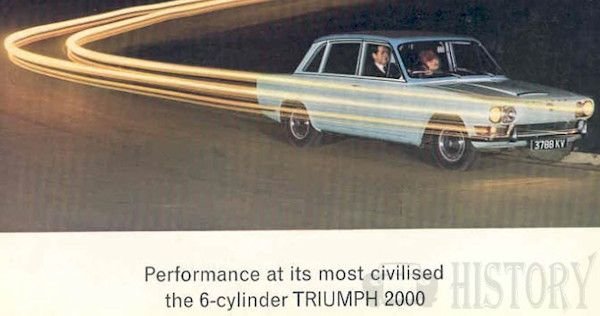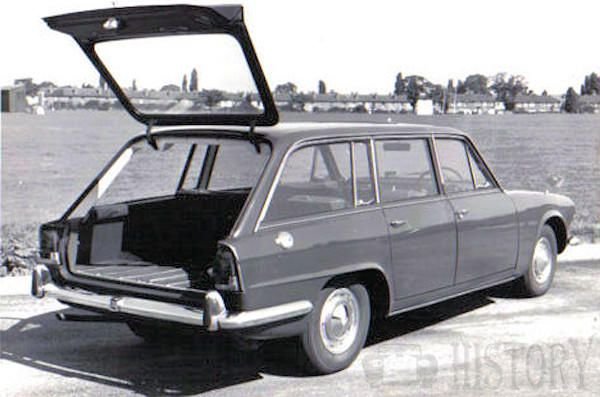Triumph 2000 MK I
| 1963 to 1977 | |
|---|---|
 |
|
| Overview | |
| Manufacturer | Triumph Motor Company |
| Production | 1963 to 1969 |
| Assembly | United Kingdom Australia |
| Designer | Giovanni Michelotti |
| Body and chassis | |
| Body style | 4-door saloon 5-door estate |
| Powertrain | |
| Engine | 1,998 cc straight-6 |
| Transmission | 4-speed manual 4-speed manual with overdrive 3-speed automatic |
| Dimensions | |
| Wheelbase | 106 in (2,700 mm) |
| Length | 174 in (4,420 mm) Mark I 183 in |
| Width | 67 in (1,702 mm) |
| Height | 56 in (1,422 mm) |
The Triumph 2000 MKI is a mid-sized, rear wheel drive automobile which was produced in Coventry by the Triumph Motor Company between 1963 and 1969. Larger-engined models, known as the Triumph 2.5 PI and Triumph 2500 were also produced.
The car used the six-cylinder engine first seen in the Standard Vanguard at the end of 1960.However, the last of the six cylinder Vanguards had applied a compression ratio of 8.0:1 which the increasing availability of higher octane fuels enabled the manufacturers to increase to 8.5:1 for the TriumphThis and the fitting of twin Stromberg 150 CD carburettors made for a claimed power output increased to 90 bhp (67 kW; 91 PS) from the Vanguard's 80 bhp (60 kW; 81 PS).
PERFORMANCE
- engine capacity 121.92 cu in, 1,998 cu cm
- fuel consumption 24 m/imp gal, 19.9 m/US gal,
- max speed 95 mph, 153 km/h
- max power (DIN): 90 hp at 5,000 rpm
- max torque (DIN): 117 1b ft, 16.1 kg m at 2,900 rpm
- max engine rpm: 5,600
- specific power: 45 hp/l
- power-weight ratio: 26.9 lb/hp, 12.2 kg/hp
- acceleration: standing 1/4 mile 19.4 sec, 0—50 mph (O—80 km/h) 9.4 sec
Standard transmission on the original car was a 4-speed manual gearbox. (overdrive and Borg-Warner Type 35 3-speed automatic transmission were options.) The monocoque body had independent suspension all-round using coil springs. The servo-assisted brakes were disc at the front and drums at the rear.
Triumph's 2000 competed with the contemporary Rover P6 2000, which initially was offered only with a four-cylinder engine. The Rover was also released in October 1963, just one week before the Triumph. Together the cars defined a new market sector in the UK, promising levels of comfort and luxury hitherto associated with larger Rover and Jaguar models, but with usefully lower running costs and purchase prices, all in a modern package.
Triumph 2000 Mark I; "Project Barb"

Although the "Mark I" was presented to the public at the London Motor Show in October 1963, volume sales began only in January 1964. Continuing in production until 1969, this version came in saloon and, from 1965, estate forms.The estate, its body shell partly built by Carbodies, was in the Mark I version the same length as the saloon. Various minor improvements were made during the period of which the most noteworthy, probably, was a significant upgrade in October 1966 to the "previously rather ineffective" ventilation, with eyeball vents added in the centre of the facia and the heater controls repositioned beneath them.

In 1968 the 2.5 PI (petrol injection) Mark I was launched, fitted with a Lucas Automotive mechanical fuel injection system. Performance was very good, but the PI models (along with the TR6 models) gained a reputation for unreliability and poor fuel economy.
In Australia these models suffered badly because of the summer heat. The electric fuel pump commonly overheated causing fuel to vaporise and render the engine inoperable until the pump cooled down. The overheating of the pump was caused by a combination of very high pressure fuel loads (over 110 psi (7.6 bar)) and a pump that was adapted from what was originally a windscreen wiper motor. As such, it did not cope well with sustained pressures in moderate to high ambient temperatures. Because of the launch late in the Mark I's life, there are relatively few PIs in the original shape.
Various models were assembled in South Africa, with the later 2500TC and 2500S being badged as the Triumph Chicane in that market between 1973 and 1978.
In New Zealand CKD production of the Triumph 2000 continued at New Zealand Motor Corporation's Nelson plant, with 2500S models until March 1979. Sir Robert Muldoon, New Zealand's then Prime Minister, privately owned a white 2500S and had been known to drive to work in it. This car is now under the owned by a member of the Auckland Triumph Car Club.The 2000 was assembled in Australia by Australian Motor Industries. A special version was known as the 2000MD ("Managing Director"), and had special features such as knock-on wire wheels, triple Stromberg carburettors and the battery moved to the boot.Total production of the 2000MD was approximately 100.
Technical
-
Triumph 2000 MKI Technical details and specifications 1963-1969)
ENGINE
location front, 4 stroke
cylinders: 6, slanted at 80, in line
bore and stroke: 2.94 x 2.99 in, 74.7 x 76 mm
engine capacity: 121.92 cu in, 1,998 cu cm
compression ratio: 9
cylinder block: cast iron
cylinder head: cast iron
crankshaft bearings: 4
valves: 2 per cylinder, overhead, push-rods and rockers
camshafts: 1, side
lubrication: eccentric pump, full flow filter
carburation: 2 Stromberg 1-50 CD semi-downdraught carburettors
fuel feed: mechanical pump
cooling system: waterTRANSMISSION
driving wheels: rear
clutch: single dry plate, hydraulically controlled
gearbox: mechanical; gears: 4 + reverse
synchromesh gears: 1st, 3rd, 4th
gearbox ratios: I 3.281, II 2.100, III 1.386, IV 1, rev 3.370
(option) Borg-Warner 35 automatic gearbox, with 3 ratios
automatic ratios (I 2.390, II 1.450, III 1, rev 2.090)
(option) Laycock-de Normanville overdrive on 3rd and 4th, 0.820 ratio
max speed in overdrive/top 98 mph, 157.8 km/h
gear lever location: central
final drive: hypoid bevel
axle ratio: 4.100 (option) 3.700
CHASSIS
type integral
front suspension: independent, by McPherson, coil springs/telescopic damper struts, lower wishbones (trailing links)
rear suspension: independent, semi-trailing arms, coil springs, telescopic dampers.STEERING
rack-and-pinion
turns of steering wheel lock to lock: 4.
turning circle (between walls): 31.8 ft, 9.7 mBRAKES
front disc (diameter 9.75 in, 248 mm), rear drum, servo
area rubbed by linings: front 190 sq in, 1,225.50 sq cm
area rubbed by linings: rear 99 sq in, 638.55 sq cm
area rubbed by linings: total 289 sq in, 1,864.05 sq cm.ELECTRICAL EQUIPMENT
voltage: 12 V
battery: 57 Ah
generator type: dynamo, 300 W
headlamps: 4
DIMENSIONS AND WEIGHT: Saloon
wheel base: 105.91 in, 2,690 mm
front track: 51.97 in, 1,320 mm
rear track: 50.39 in, 1,280 mm
overall length: 173.82 in, 4,415 mm
overall width: 64.96 in, 1,650 mm
overall height: 55.91 in, 1,420 mm
ground clearance: 5.91 in, 150 mm
dry weight: 2,425 1b, 1,100 kg
distribution of weight: 54.6% front axle, 45.4% rear axleDIMENSIONS AND WEIGHT: Estate
wheel base: 106 in. 2,692 mm
front track: 52 in. 1.321 mm
rear track: 50.50 in, 1,283 mm
overall length: 174 in, 4,420 mm
overall width: 65 in, 1,651 mm
overall height: 56 in, 1,422 mm
ground clearance: 6 in, 152 mm
dry weight: 2,549 1b, 1.156 kg© Motor car History
Service
-
Triumph 2000 MKI Maintenance and Service Guide 1963-1969)
Fuel type: 90 oct petrol
Engine oil change: 8 imp pt, 9.51 US pt, 4.5 1, SAE 20W-30, change every 6,000 miles, 9,700 km
Maximum system capacity: 9 imp pt, 10.78 US pt
Cooling system capacity: 13.50 imp pt, 16.28 US pt
Gearbox oil: 2.50 imp pt, 2.96 US pt, 1.4 1, SAE 90, no change recommended
Final drive oil: 1.75 imp pt, 2.11 US pt, 1 1, SAE 90, no change recommended
Spark plug type: 2250
Tappet clearances: inlet 0.010 in, 0.25 mm, exhaust 0.010 in, 0.25 mm
Normal tyre pressure: front 26 psi, 1.8 atm, rear 26 psi, 1.8 atm.
Tyres: 6.50 x 13
Fuel tank capacity: 11.5 imp gal or 14 imp gal, 16.9 US gal
Carrying capacity: 882 1b, 400 kg© Motor car History
